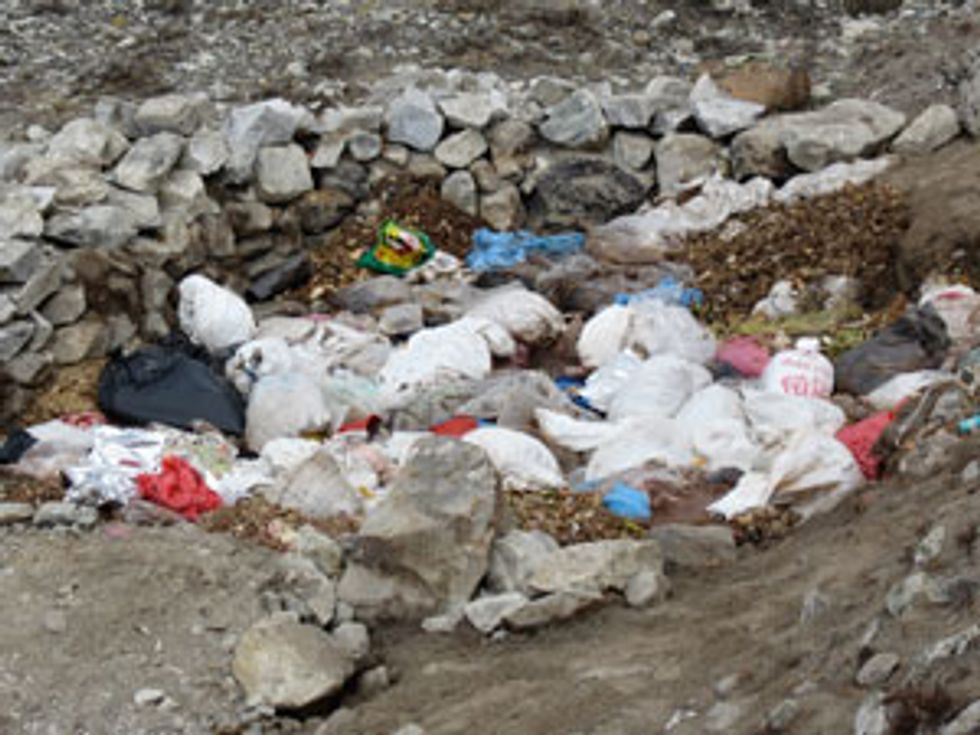For many amateur climbers, summiting Mount Everest represents one of life’s greatest challenges and achievements. But for the Nepalese and foreign professionals who work there, the larger challenge is figuring out how to keep the place clean.
Efforts to beautify what’s frequently called “the world’s highest garbage dump” have been under way for more than a decade, with mixed results. Spent oxygen canisters, empty beer bottles, and tattered tents recovered from the mountain can often be reused or recycled, but human waste is a messier problem. Each year, porters haul down some 12,000 kilograms of poop from base camps at Everest and the nearby Pumori, Lhotse, and Nuptse mountains. Getting the material off the mountain is one thing; however, properly disposing of it is another.
The waste is currently delivered on foot to Gorak Shep, the nearest village to Everest, sitting at 5,164 meters (3.2 miles) above sea level. The porters drop the poop into unlined pits, leaving the raw excrement to slowly dehydrate and break down in the open air, which, at such high altitudes, can take years. In the meantime, the waste mars the landscape and potentially contaminates the town’s water supply. Both the Nepalese government and the climbing community recognize that this method of disposal is a hazard to environmental as well as human health, but given the remoteness of the site and the magnitude of the problem, solutions have remained elusive.
A team of volunteer engineers might be just what Nepal needs, however. Members of the Mt. Everest Biogas Project, as it’s called, say they have a potential fix: a specially designed biogas reactor that can transform Gorak Shep’s fetid trenches into energy. Not only would it eliminate the need for the poop pits, it would also provide the village with a bountiful, free source of methane, which could be used as fuel for cooking and heating homes.
Garry Porter, a retired Boeing engineer based in Seattle, and his buddy Dan Mazur, a professional mountaineer, hatched the idea back in 2010. Mazur lives in Nepal and Tibet for half the year and regularly leads climbs up Everest, so he was well aware of the poop predicament. Porter became intimate with it in 2003, when he attempted to scale Everest. “The Nepalese consider this their sacred mountain, and we’re defecating on it,” he says.
Thousands of biogas reactors already operate at lower altitudes throughout Nepal, but temperatures at Gorak Shep prevent the needed waste-devouring bacteria from thriving. Recognizing this, Mazur asked Porter if he thought it would be possible to create a biogas digester that could function in the cold. Porter did, and the project was born.

After recruiting about a dozen other engineer volunteers, Porter and his team began brainstorming a solution, keeping in mind that they could use only materials that are readily available in Kathmandu, Nepal’s capital. Rather than build something from scratch, they decided to figure out a way to insulate the preexisting design, a 6-cubic-meter model that, if kept warm enough, could process all the climber waste currently dumped in Gorak Shep.
Having worked through several iterations, the team settled on a relatively straightforward solution. The digester itself will be swaddled in R-50 (heavy) insulation, and a 200-watt resistor coil—similar to those found in water heaters—will deliver heat. The contents of the digester, which is buried in the ground, must remain at 30 °C or higher. Given the ground and air temperature, the engineers calculated that doing this would require an average of 100 W, a figure that they doubled to be safe.
There was another problem, of course: Gorak Shep has no access to electricity. (A few telecom companies serving climbers have photovoltaic installations for their own needs.) Consulting meteorological databases, the team determined that—given the maximum summer and minimum winter temperatures, plus days of cloud cover and snow—an array of 16 photovoltaic solar panels would be able to produce the needed 200 W. A bank of Exide LMXT 2-volt batteries, which are designed for use with solar arrays, is also needed to keep the digester running at night and on overcast days. The whole thing will be topped off with a shelter, which the volunteer group Architects Without Borders has offered to design.
Porter and the other engineers recently submitted a 27-page “Basis of Design” for peer review to engineers not involved in the project. In February, it was returned with the reviewers’ stamp of approval. The Nepalese government, residents of Gorak Shep, and the climbing community have all responded enthusiastically as well. Now the biogas team is working on estimating the price—certainly in the thousands of dollars, the engineers say—of building and installing the digester, which will be funded entirely by donations. Construction is tentatively slated for 2016. “Our intent is to build one, get it up and running, train local operators—and then the horses leave town,” Porter says. “But we will have people in Seattle and Kathmandu who can provide technical support for the life of the system.”
If successful, the project could be replicated in other locations that are too cold for traditional digesters. “In places like Alaska they have an expensive solution—they helicopter the waste out—but that’s not available in a lot of developing countries where there aren’t even treatment plants they can helicopter it to,” Porter says. “If we can bring this technical solution to bear on a universal problem, then hey, that’s great.”
This article originally appeared in print as “Waste-to-Energy at the Roof of the World.”
About the Author
Rachel Nuwer is a Brooklyn, N.Y.-based journalist who writes for the New York Times, Smithsonian, Scientific American, and New Scientist among other publications. A globe trotter, she's been in 51 countries and lived in six.
